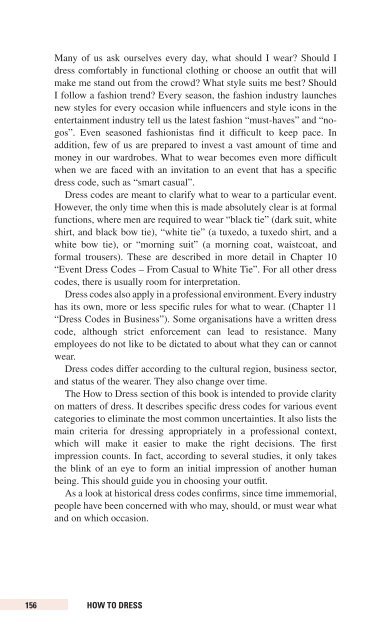Leseprobe: Zehnder/Senn: How to Meet, Host & Dress
Sie wollen auch ein ePaper? Erhöhen Sie die Reichweite Ihrer Titel.
YUMPU macht aus Druck-PDFs automatisch weboptimierte ePaper, die Google liebt.
Many of us ask ourselves every day, what should I wear? Should I<br />
dress comfortably in functional clothing or choose an outfit that will<br />
make me stand out from the crowd? What style suits me best? Should<br />
I follow a fashion trend? Every season, the fashion industry launches<br />
new styles for every occasion while influencers and style icons in the<br />
entertainment industry tell us the latest fashion “must-haves” and “nogos”.<br />
Even seasoned fashionistas find it difficult <strong>to</strong> keep pace. In<br />
addition, few of us are prepared <strong>to</strong> invest a vast amount of time and<br />
money in our wardrobes. What <strong>to</strong> wear becomes even more difficult<br />
when we are faced with an invitation <strong>to</strong> an event that has a specific<br />
dress code, such as “smart casual”.<br />
<strong>Dress</strong> codes are meant <strong>to</strong> clarify what <strong>to</strong> wear <strong>to</strong> a particular event.<br />
<strong>How</strong>ever, the only time when this is made absolutely clear is at formal<br />
functions, where men are required <strong>to</strong> wear “black tie” (dark suit, white<br />
shirt, and black bow tie), “white tie” (a tuxedo, a tuxedo shirt, and a<br />
white bow tie), or “morning suit” (a morning coat, waistcoat, and<br />
formal trousers). These are described in more detail in Chapter 10<br />
“Event <strong>Dress</strong> Codes – From Casual <strong>to</strong> White Tie”. For all other dress<br />
codes, there is usually room for interpretation.<br />
<strong>Dress</strong> codes also apply in a professional environment. Every industry<br />
has its own, more or less specific rules for what <strong>to</strong> wear. (Chapter 11<br />
“<strong>Dress</strong> Codes in Business”). Some organisations have a written dress<br />
code, although strict enforcement can lead <strong>to</strong> resistance. Many<br />
employees do not like <strong>to</strong> be dictated <strong>to</strong> about what they can or cannot<br />
wear.<br />
<strong>Dress</strong> codes differ according <strong>to</strong> the cultural region, business sec<strong>to</strong>r,<br />
and status of the wearer. They also change over time.<br />
The <strong>How</strong> <strong>to</strong> <strong>Dress</strong> section of this book is intended <strong>to</strong> provide clarity<br />
on matters of dress. It describes specific dress codes for various event<br />
categories <strong>to</strong> eliminate the most common uncertainties. It also lists the<br />
main criteria for dressing appropriately in a professional context,<br />
which will make it easier <strong>to</strong> make the right decisions. The first<br />
impression counts. In fact, according <strong>to</strong> several studies, it only takes<br />
the blink of an eye <strong>to</strong> form an initial impression of another human<br />
being. This should guide you in choosing your outfit.<br />
As a look at his<strong>to</strong>rical dress codes confirms, since time immemorial,<br />
people have been concerned with who may, should, or must wear what<br />
and on which occasion.<br />
156 HOW TO DRESS
















